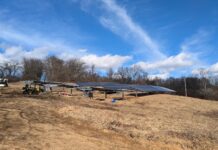
Ohio’s program to plug abandoned oil and gas wells has been chronically underachieving, according to a new state audit.
While the ODNR’s Division of Oil and Gas Resources drastically increased the number of wells plugged each year — from 10 in 2013 to 202 in 2021 — it failed each year to reach the spending requirements set by the state.
The Ohio Department of Natural Resource’s Orphan Well Program is required by state law to use 30% of annual collections from the state’s oil and gas severance tax, a goal that has never been met. To hit the 30% mark, the department would have to double its staff. That’s what was reported in a new performance audit of the program released Aug. 9, by the Ohio state auditor.
The program also lacks data on many of the abandoned wells believed to be in the state, according to the audit. There are an estimated 36,000 to 66,000 orphan wells, or abandoned wells without a legal owner. The department has 970 wells in its official orphan well inventory and many of those may lack accurate location and environmental data, according to the audit.
“ODNR’s Orphan Well Program is moving in the right direction, but there’s still much work to do,” said Auditor of State Keith Faber, in a statement. “We need to pick up the pace.”
Compounding problems
The orphan well program was created in 1977 to address the thousands of wells abandoned before modern oil and gas regulations were put in place.
About 175,000 oil and gas wells were drilled in Ohio, from the 1860s to the creation of the Division of Oil and Gas Resources in 1965. It was common practice during this time to abandon wells once they ran dry. That left a lot of environmental and safety hazards scattered around the Ohio countryside. Orphan wells can leak oil or gas into the surrounding air, oil and groundwater.
The audit found the department needs to put more wells out to bid, hire more contractors and improve data collection and staffing for the program.
Last year was the program’s best year for plugging wells, spending $11.2 million to plug more than 200 wells, but it still only hit 14.9% of its spending allotment. To meet the 30% target, the division should have plugged 373 wells and spent $22.5 million, according to the audit.
The division has a bank of 44 approved contractors, but only 20 plugged an orphan well last year.
“On average, a well plugging crew can plug a single well in about 10 business days, so any given contractor can be expected to be able to plug about 24 wells per year,” the report stated. “Hypothetically, this means that the 44 approved contractors could be able to plug around 1,000 wells per year.”
The division uses its employees for the vast amount of orphan well pre-work to get wells ready to go to bid. It takes about 300 hours of staff work to prep and oversee the well plugging process for one well, according to the ODNR. In 2021, that amounted to more than $3 million.
The ODNR interprets the state law to mean that only plugging contracts counts towards the 30% spending requirement, meaning internal staff work on the program doesn’t count toward the goal. Including that $3 million would only have brought the program’s spending up to 19%, still short of the goal, the audit found.
Spending issues
Another problem the program faced in meeting its spending goal was, paradoxically, the success of the industry, which pumped an enormous amount of money into the program’s coffers in the last decade.
Severance tax revenue increased by over 1,000% during the shale gas boom, from $7.2 million in 2012 to $81 million in 2019 at the peak of the state’s natural gas production. This meant that each year more money was available to the program that was already not hitting its spending goals.
Then in 2018, a state law gave the orphan well program a bump in state funding, increasing the amount earmarked for the program from 14% to 30% of the state’s oil and gas severance tax. While this was good for boosting the program’s productivity — more staff was hired and more contractors were secured — it also moved the spending target that the division was already having trouble meeting.
The department is restricted in how it can use severance tax money so the unspent money continues to pile up. There is more than $180 million sitting in the oil and gas well fund that can only be used by the division, according to the audit.
Response
ODNR director Mary Mertz said in the letter responding to the audit that the department has had difficulty finding contractors.
She said the department awarded the entirety of the set-aside funding for plugging wells for 2022, but gave no explanation for why it had failed to plug enough wells for years.
Earlier this year, the division announced efforts to grow its orphan well program, thanks in part to a boost in funding from the federal infrastructure bill passed late last year. An estimated $326 million in federal funds will be available to Ohio through 2035.
With the federal funding available, the division planned to hire more contractors and consultants to help with all parts of the plugging process, including flying drones to locate wells, designing plugging plans, overseeing construction and plugging the wells. A public information campaign was also launched to get residents to report orphan wells to the division.
Mertz also said they worked with the General Assembly in the spring to change state law to include all direct costs involved with plugging a well to be charged to the spending requirement.
(Reporter Rachel Wagoner can be reached at rachel@farmanddairy.com or 724-201-1544.)









